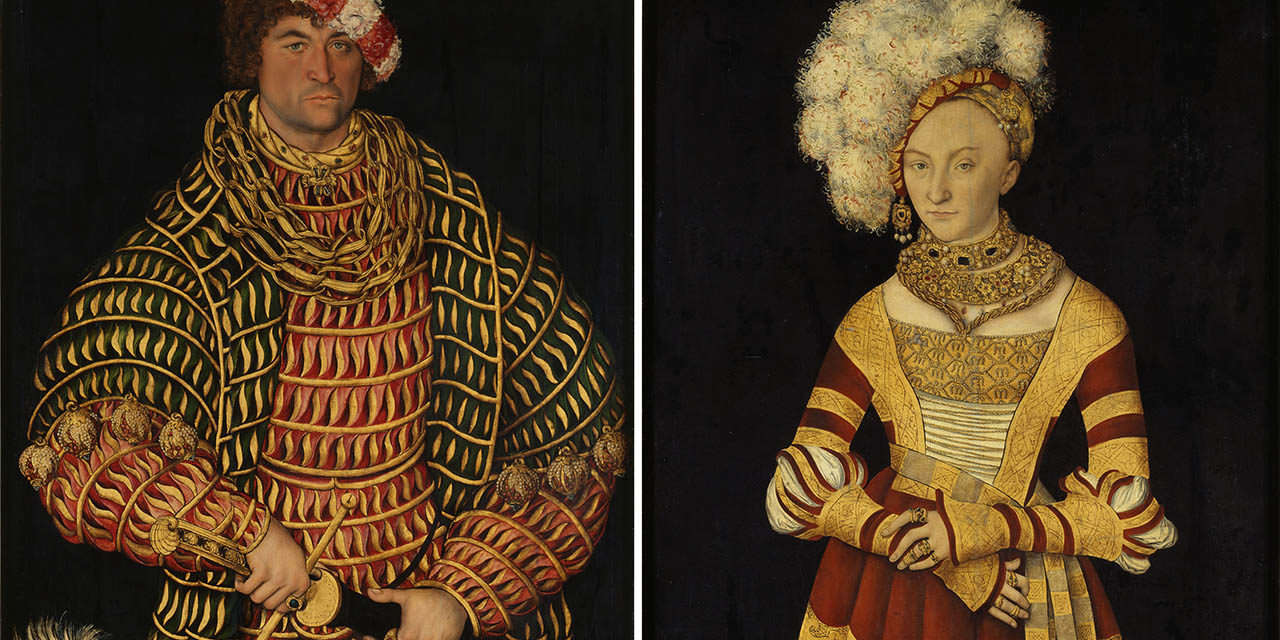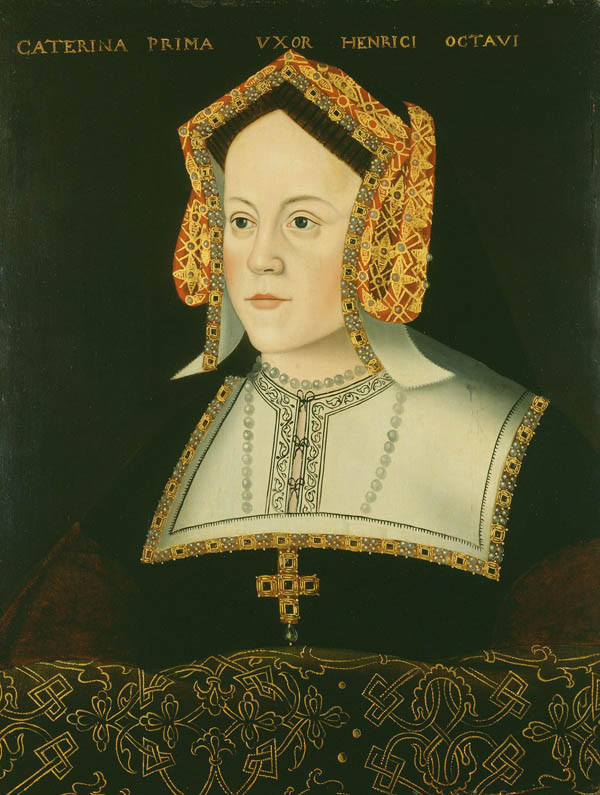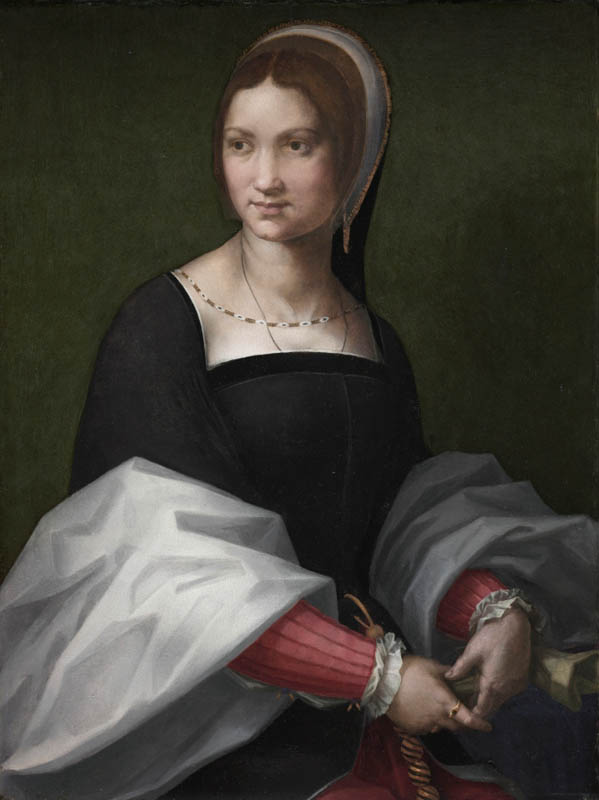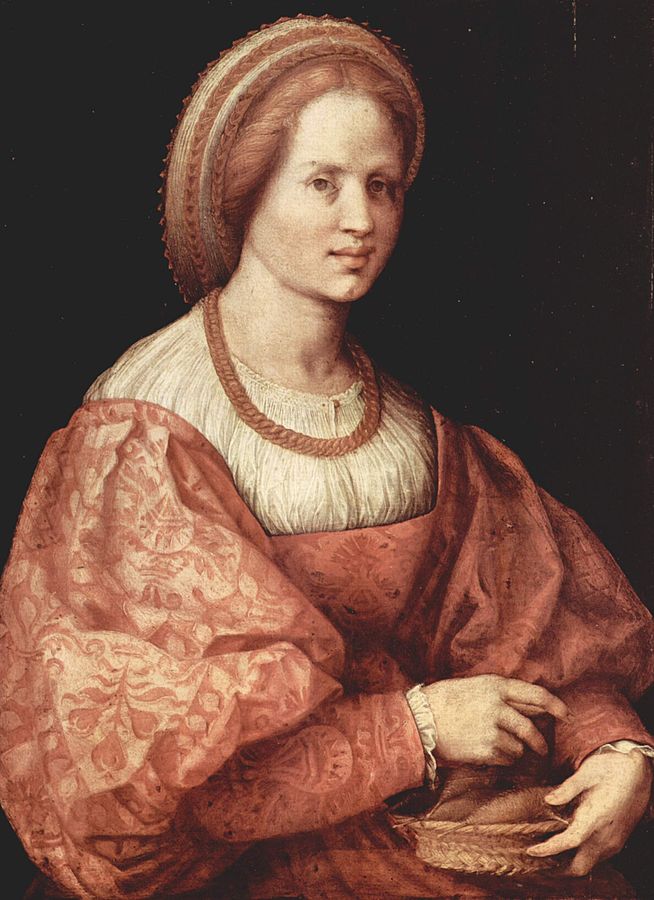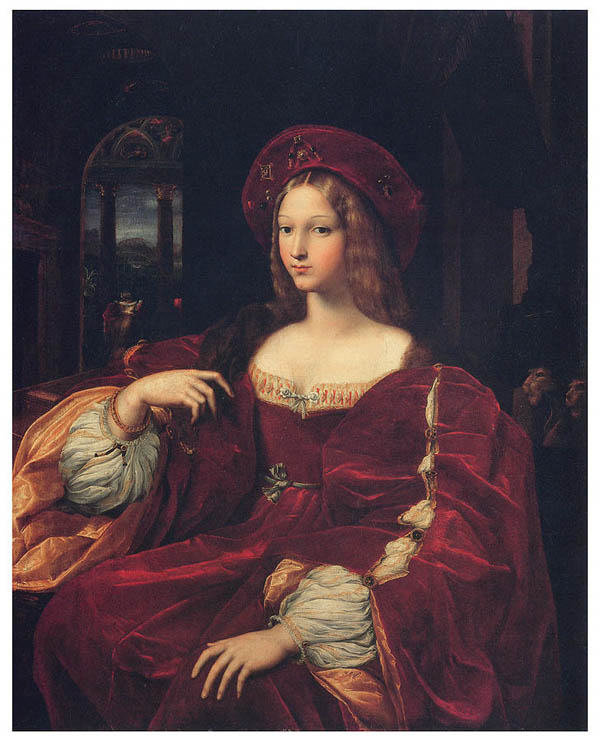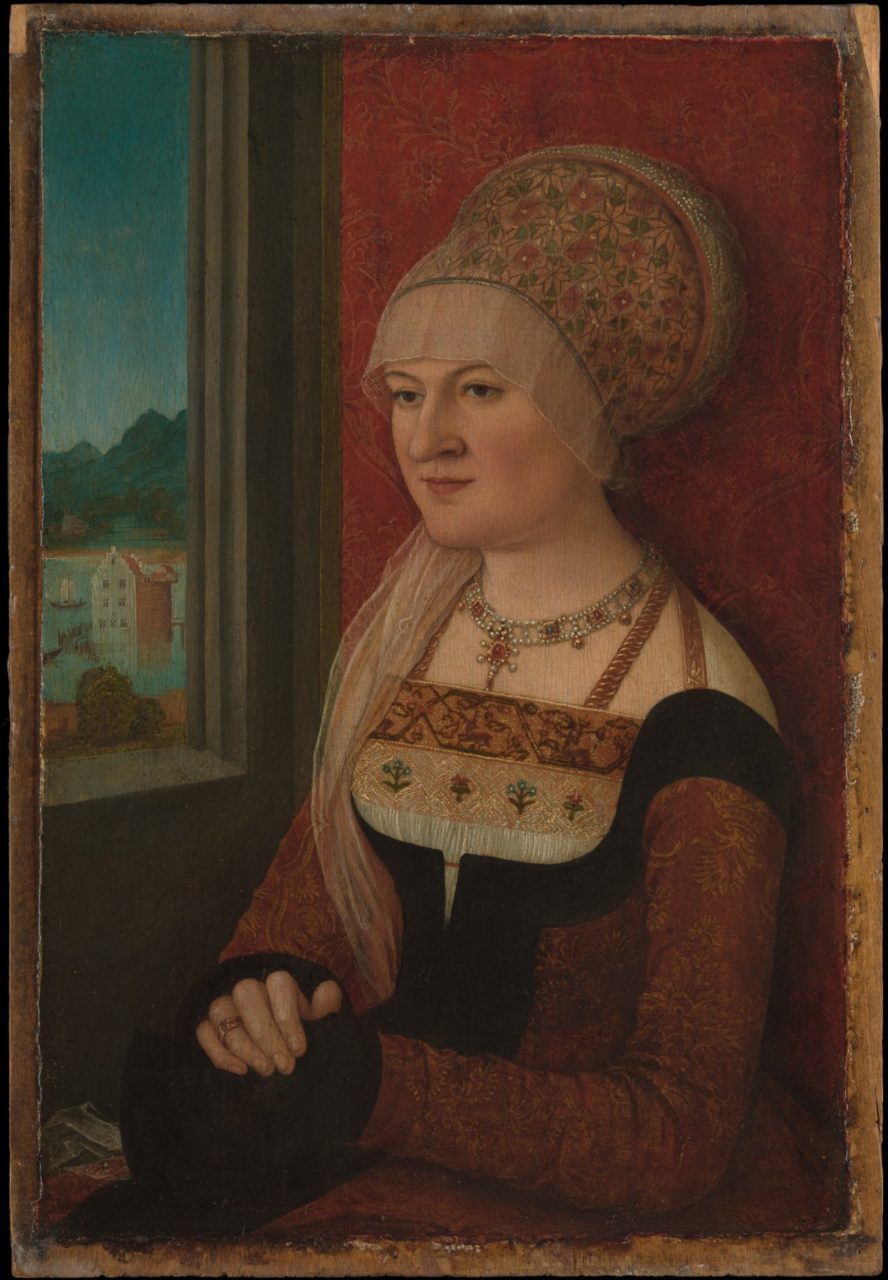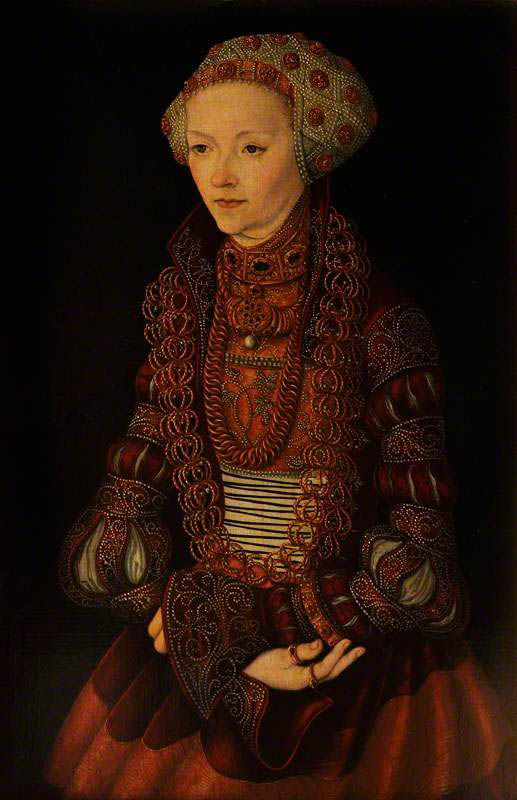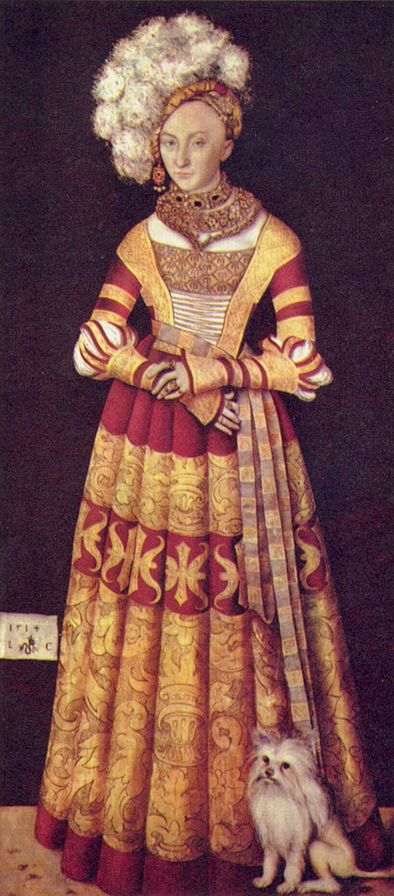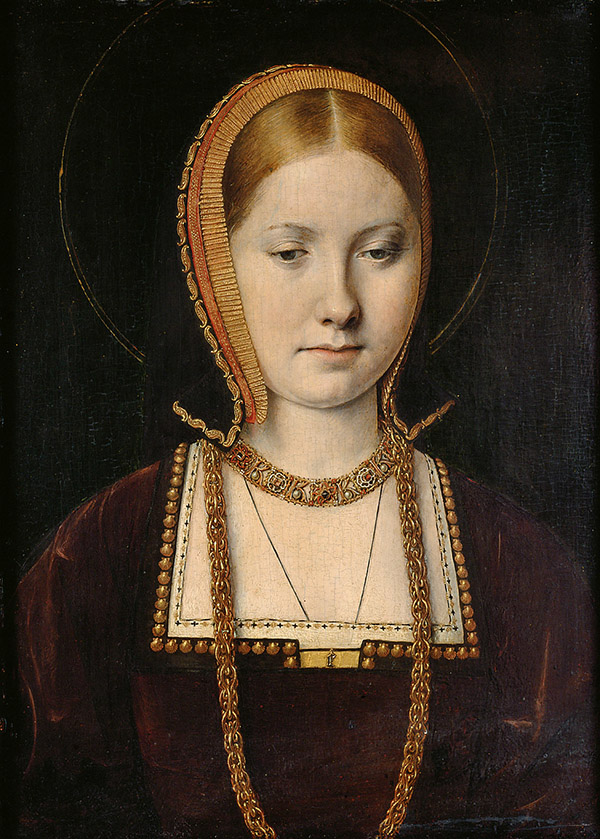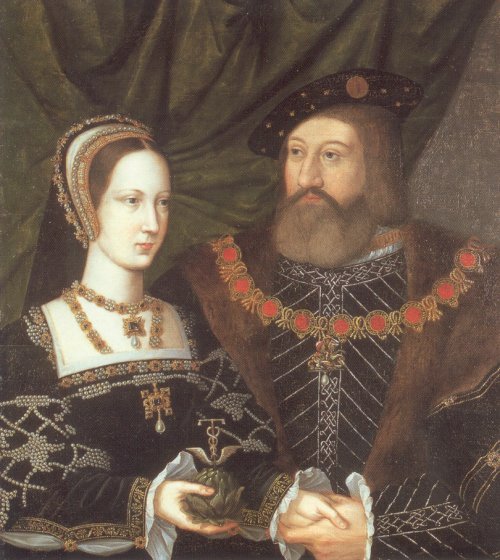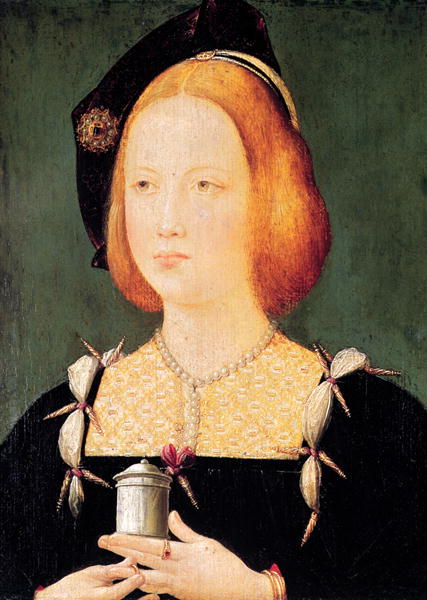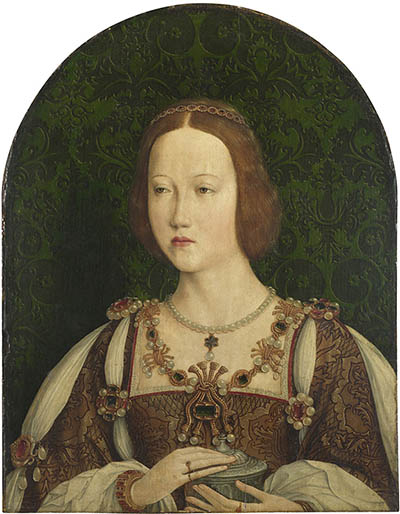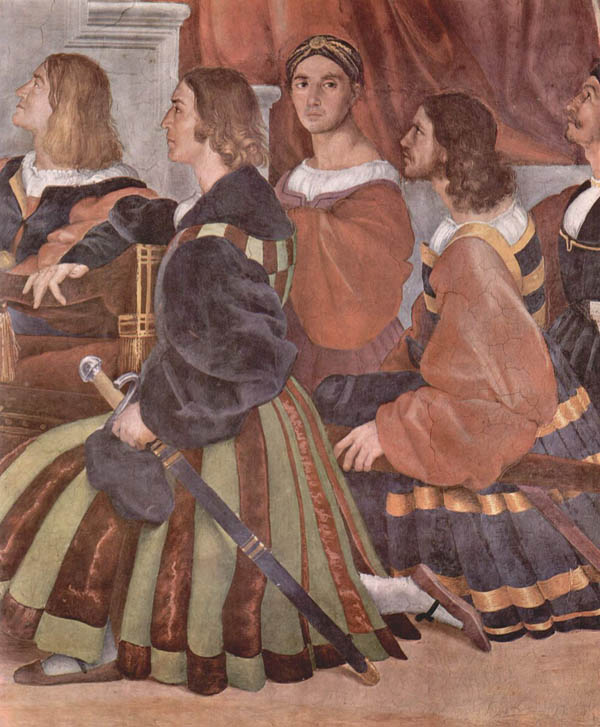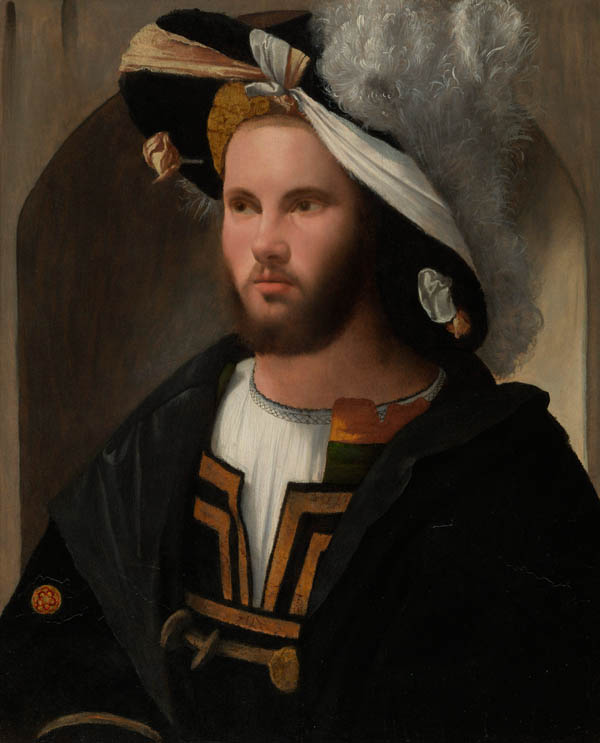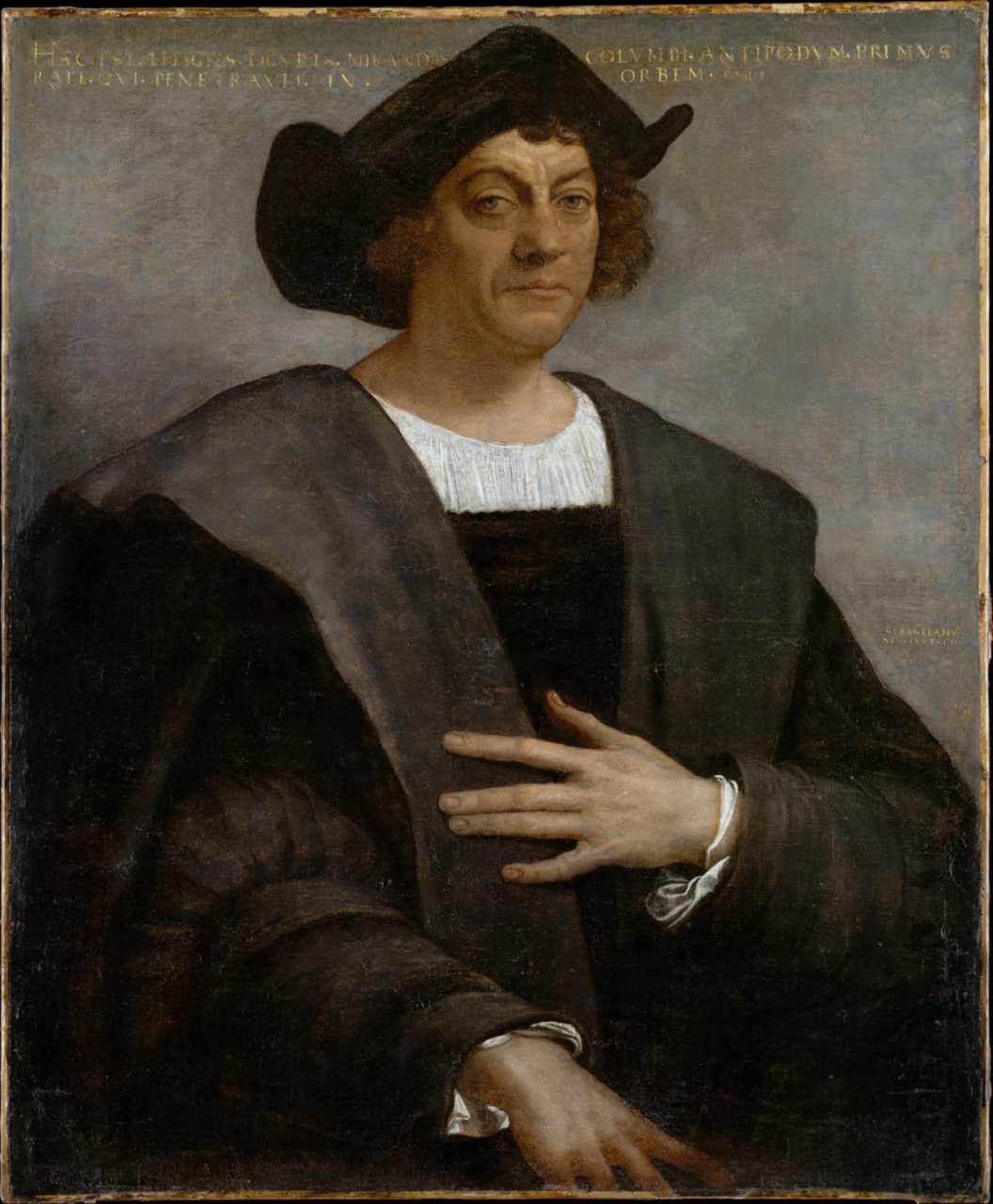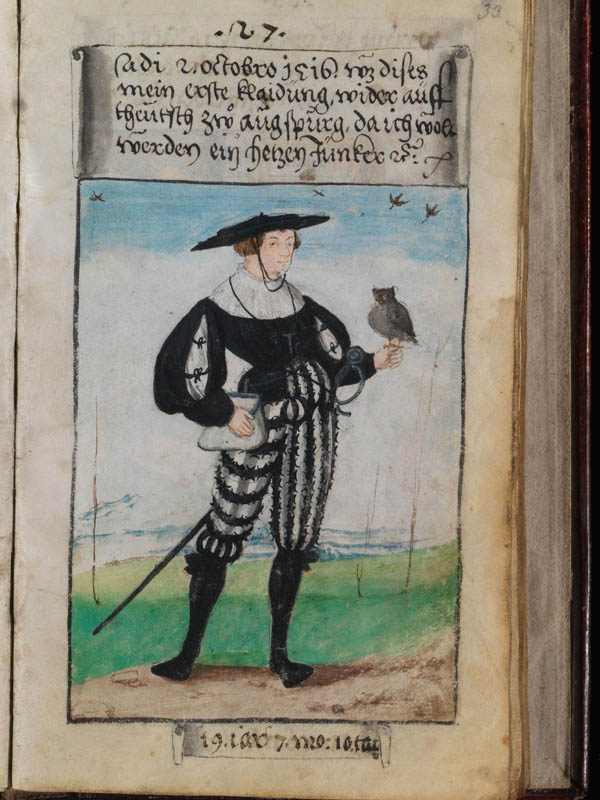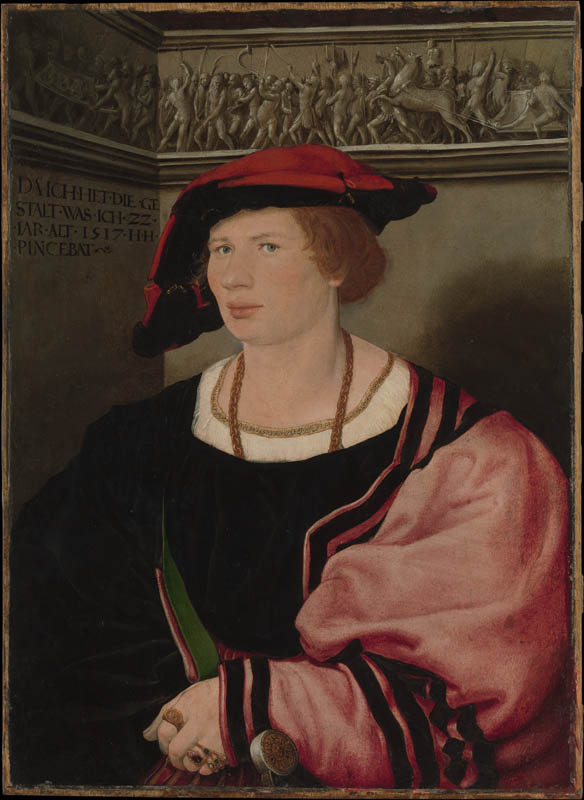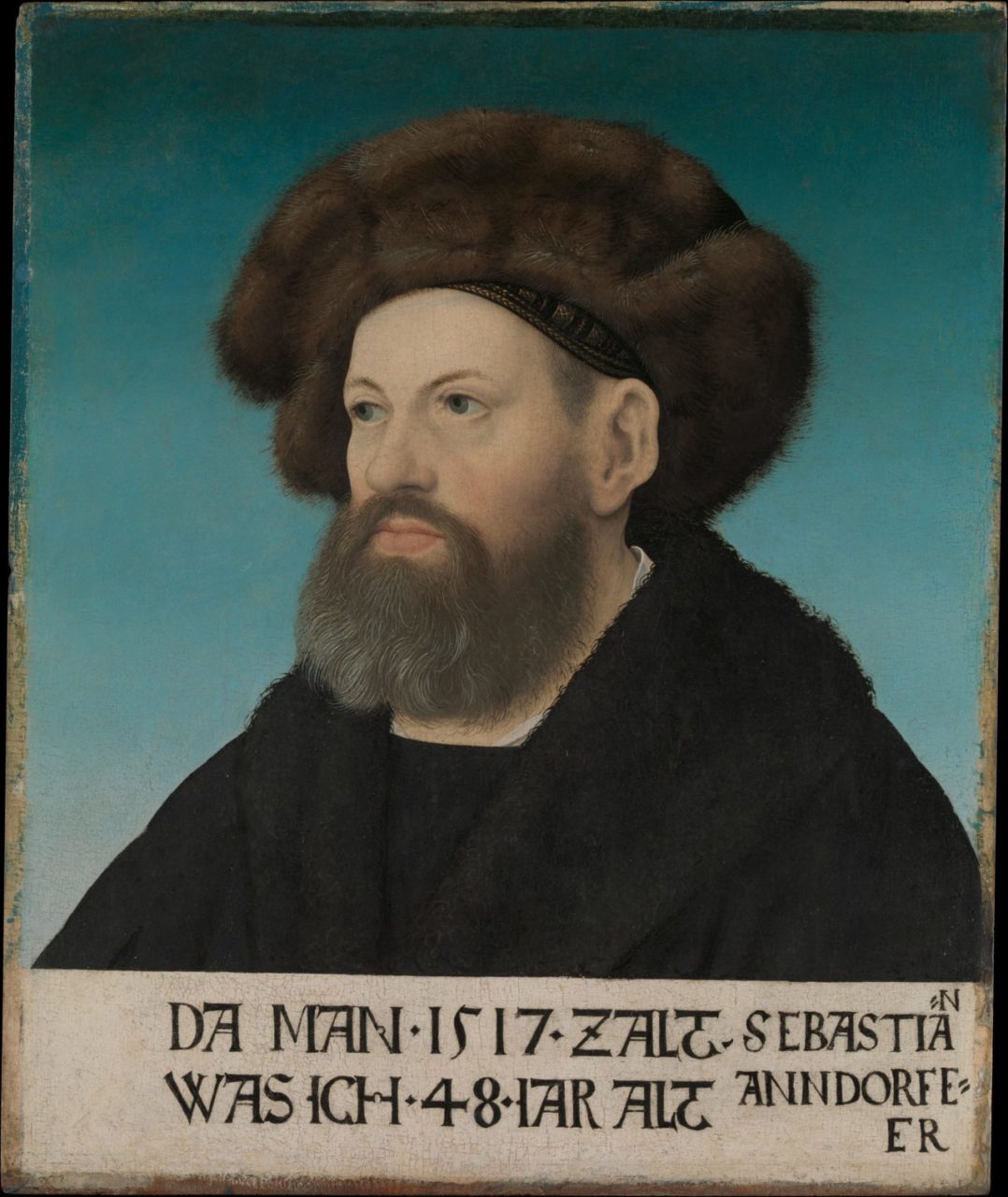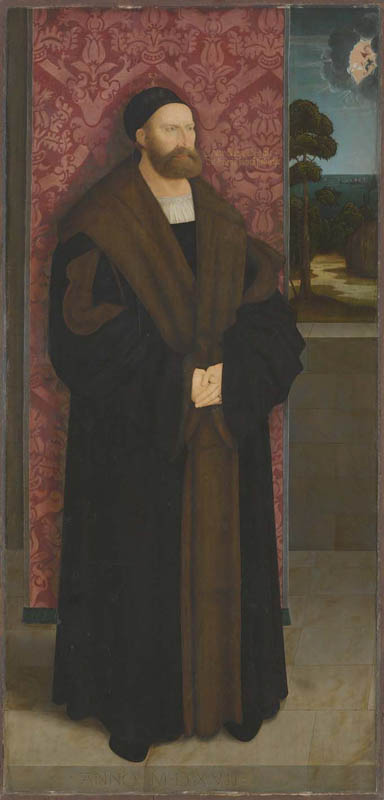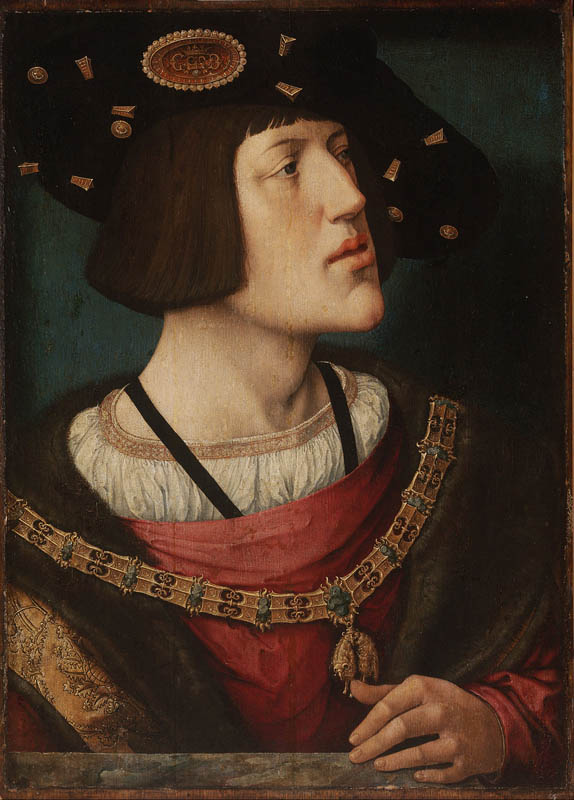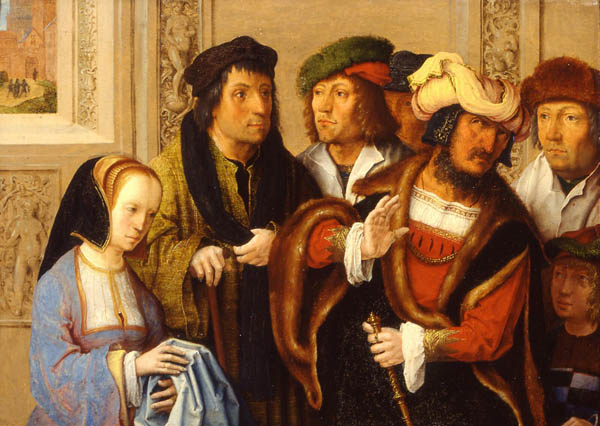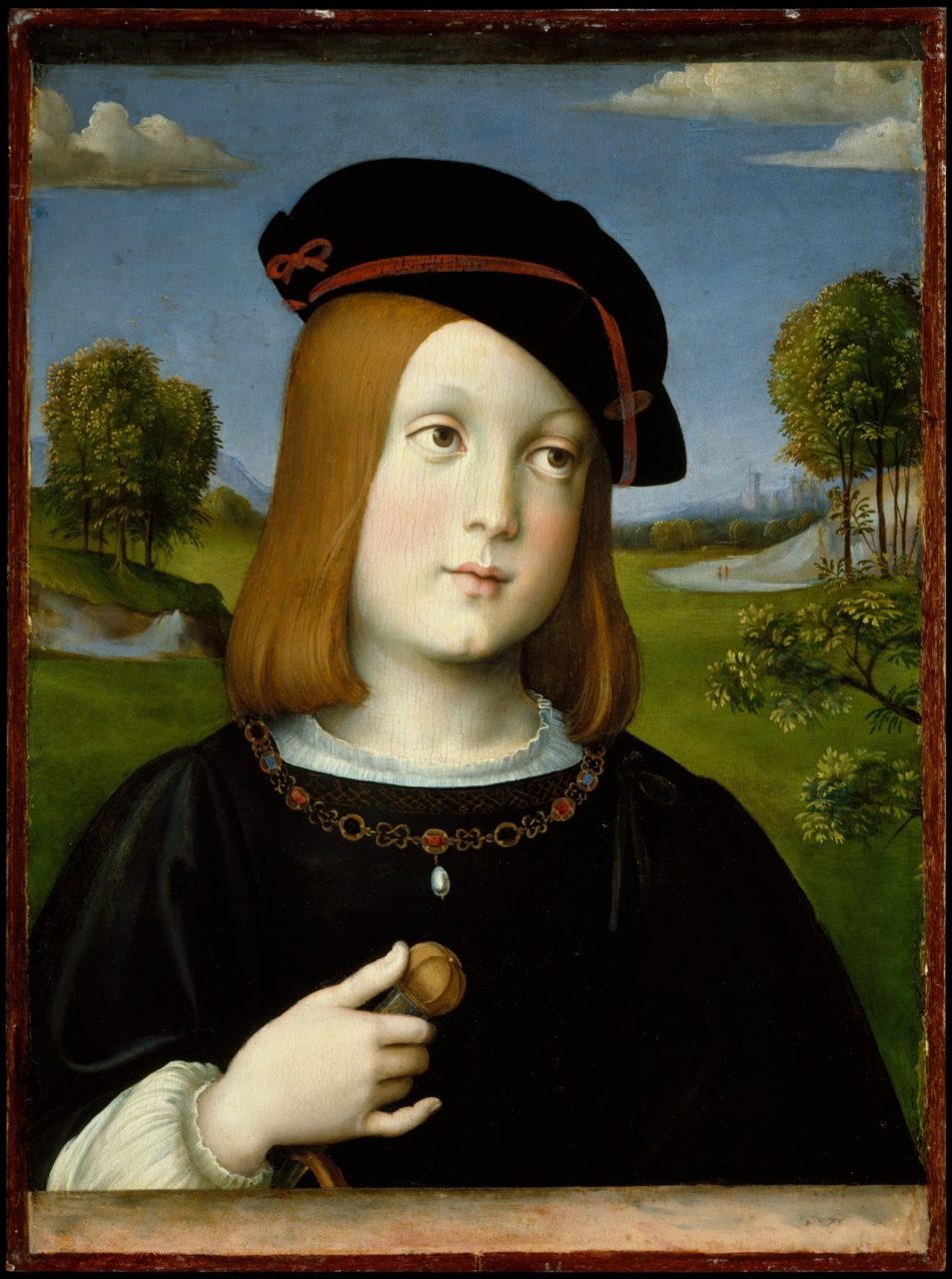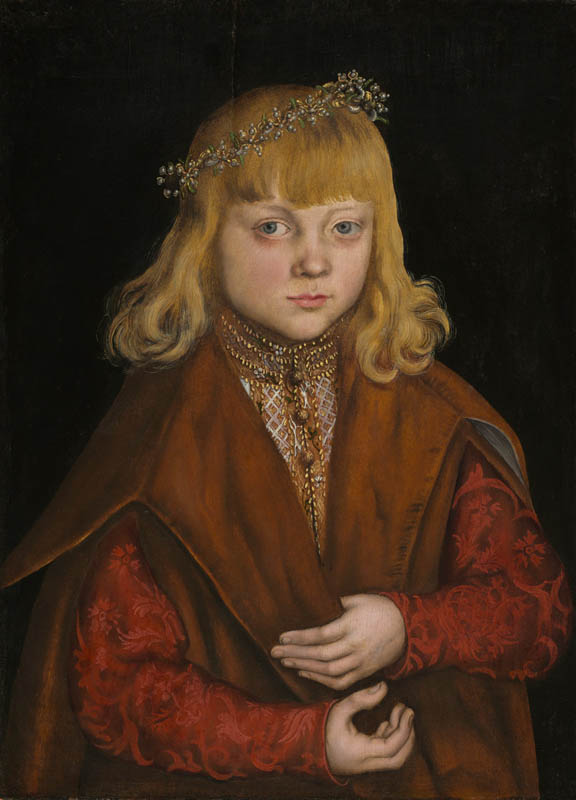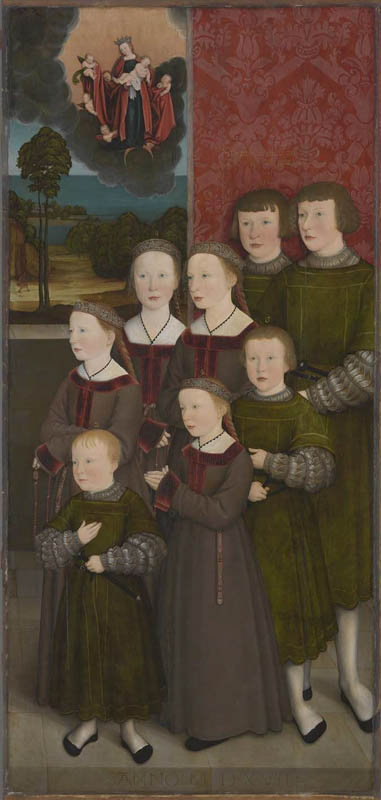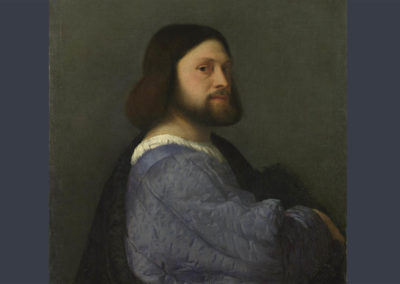OVERVIEW
The second decade of the 16th century featured broad-shouldered silhouettes for men and women, paired with immense sleeves (except for women in Germany, who retained narrow sleeves). Slashing, pinking, paning and other decorative fabric treatments like blackwork embroidery were increasingly common.
Womenswear
In the second decade of the 16th century, the costume components for womenswear were the same as in 1500-1509. The foundation layer for all clothing was a smock/shift/chemise made of linen, often ornamented with blackwork or other colored embroidery. A good example of blackwork can be seen in the ca. 1515 portrait of Catherine of Aragon (Fig. 1), where a band of blackwork embroidery decorates the neck opening of her shift. The Royal Collection Trust comments further, writing:
“Catherine’s white linen shift is decorated with blackwork, a style of embroidery believed to have its origins in the geometric Moorish designs found in Spain. The popularisation of both blackwork in England and the so-called Spanish farthingale, a stiffened cone-shaped underskirt, are often credited to the arrival of the Spanish queen and her entourage. Catherine wears an English or gable hood, consisting of a piece of white linen fabric edged with a jewel-set band, beneath red cloth of gold lappets set with pearls pinned up over each ear. Two pieces of black fabric hang from the crown of the head down her back. The geometric shape surrounding the face is achieve through the use of a wire support.”
While the gabled hood was the typical English headdress, in France women preferred what came to be known as the French hood. The unknown woman, thought to be French, in a ca. 1518 portrait (Fig. 2) in the circle of Andrea del Sarto wears the rounded French hood, which was set back farther on the head. Her gown has an Italian-inspired low, square-cut neckline. Her red striped kirtle sleeves are narrow and the open seams are closed by golden points, with her chemise puffed out. Her gown has an inverted V-shaped opening in the front, revealing the kirtle front, a trend we first saw on Anne of Brittany (see Fashion Icon in 1500-1509). A heavy gold girdle extends down from her waist.
Fig. 1 - British School (16th century). Catherine of Aragon (1485-1536) ca. 1515, copy executed ca. 1550-99. Oil on wood; 57.5 x 44.6 cm. Hampton Court Palace, RCIN 404746. Source: Royal Collection Trust
Fig. 2 - Circle of Andrea del Sarto (Italian, 16th century). Portrait of a Woman, ca. 1518. Oil on wood; 82.5 x 62.2 cm (32.5 x 24.5 in). Cleveland: Cleveland Museum of Art, 1944.92. Source: Cleveland
Fig. 3 - Titian (Italian, 1488-1576). Profane Love, detail, 1514. Oil on canvas; 118 x 279 cm (46.4 x 109.8 in). Rome: Galleria Borghese, 147. Source: Galleria Borghese
Fig. 4 - Pontormo (Italian, 1494-1557). Lady with a Basket of Spindles, 1516. Oil on panel; 76 × 54 cm (29.9 × 21.3 in). Florence: Uffizi Gallery. Source: Wikimedia
Fig. 5 - Raphael (Italian, 1483–1520). Doña Isabel de Requesens y Enríquez de Cardona-Anglesola, 1518. Oil on canvas; 120 × 95 cm (47.2 × 37.4 in). Paris: Louvre Museum, INV 612. Source: Wikimedia
In Italy
Italian women continued to favor extremely broad, low-cut gowns with enormous sleeves. Daniel Delis Hill describes Italian womenswear in his History of World Costume and Fashion (2011):
“Italian women’s gowns of the transitional period in the early 1500s mirrored the full, flowing forms of men’s fashions. Necklines were cut wide and deep, and sleeves were massive. The bodice was still laced tightly to be form-fitting and was girded above the natural waistline. Skirts were pleated or gathering for an opulent fullness. Under gowns of contrasting colors were displayed at the hemline, bodice, and particularly the sleeves.” (359)
The figure of Profane Love in Titian’s 1514 painting (Fig. 3) exemplifies these trends. She wears a pale blue gown over a red kirtle, whose sleeves and hem are in striking contrast to the rest of the gown. Visible due to the low-cut bodice of her gown, her chemise is finely pleated and decorated with a band of gold embroidery at the neck. The gown is girded above the natural waistline with a gold and jeweled girdle and her sleeves are leg-of-mutton style.
Pontormo’s Lady with a Basket of Spindles (Fig. 4) wears the same leg-of-mutton sleeves, which begin nearly off the shoulder. Though her gown bodice is similarly deep, she creates a more modest effect with a higher-cut chemise. This may have not been entirely of her own choosing, as François Boucher notes in his History of Costume in the West (1997): “restrictions against low-cut necklines were imposed in Genoa and Milan in 1512 and in Rome in 1520; in 1514 Venice laid down sumptuary laws and set up a special controlling office” (222).
Doña Isabel de Requesens y Enríquez de Cardona-Anglesola (Fig. 5), the Spanish wife of the viceroy of Naples, wears a red velvet gown with a deep neckline, which reveals the extremely elaborate gold embroidery on her chemise. The open seams of her large sleeves reveal yet more of the golden embroidery work on the chemise sleeves. Spanish enthusiasm for silver and gold embroideries was such that the Spanish government issued sumptuary laws banning their use four times in 1515, 1520, 1523, and 1534 (Boucher 227); Doña Isabel escaped such restrictions as she was living in Naples. Her gown sleeves are lined in gold fabric and closed by clasps in the shape of a wagon wheel. She holds a zibellino, or marten with jeweled head—a very fashionable Italian accessory—in her right hand.
Fig. 6 - Bernhard Strigel (German, 1460–1528). Portrait of a Woman, ca. 1510–15. Oil on linden; 38.4 x 26.7 cm (15 1/8 x 10 1/2 in). New York: The Metropolitan Museum of Art, 71.34. Purchase, 1871. Source: The Met
Fig. 7 - Bernhard Strigel (German, 1460-1528). Sibylla von Freyberg, geb. Gossenbrot, 1513. Oil on panel; 61 x 35.8 cm. Munich: Alte Pinakothek. Source: Alte Pinakothek
Fig. 8 - Lucas Cranach the Elder (German, 1472-1553). Portrait of an Unknown Lady, 1515. Oil on panel; 55.5 x 37.5 cm. Waddesdon Manor. Source: ArtUK
Fig. 9 - Lucas Cranach the Elder (German, 1472–1553). Duchess Katharina von Mecklenburg, 1514. Oil on canvas; 184.4 x 83 cm. Dresden: Gemäldegalerie Alte Meister. Source: Google Arts & Culture
In Germany
German women continued to prefer gowns with narrower sleeves and extremely deep bodices that revealed elaborate embroidery across the bust of the chemise. Bernhard Strigel’s portrait of an unknown woman (Fig. 6) depicts her wearing a red brocade gown edged in black velvet, with gold and colored embroidery on the chemise depicting flowers and stags in a forest. Anna Reynolds describes the very typical German headdress seen in the portrait in A Cultural History of Dress and Fashion in the Renaissance (2017):
“Her hair is completely covered by a fine linen veil or Steuchlein, which was standard attire for married German women of all classes, and is tied at the nape of the neck. It is worn over a large padded support cap beneath known as a Wulsthaube.” (Reynolds)
Her wulsthaube is also covered in detailed, colorful floral embroidery. As is that of Sibylla von Freyberg (Fig. 7), who also wears a similar silhouette, though her bust is covered in gold brocade cloth, as are her turned back sleeve cuffs, rather than embroidery. Lucas Cranach the Elder’s portrait of an unknown lady (Fig. 8) and of the Duchess Katharina von Mecklenburg (Fig. 9) both wear gowns with front lacing across the bodice and narrow, paned sleeves, with the chemise puffing out at the elbows. Both have pearl-accented embroidery at the bust and wear heavy gold necklaces in the German style.
Fashion Icon: Mary Tudor, Queen of France
Fig. 1 - Michiel Sittow (1468-1525). Mary Rose Tudor (1496-1533), 1514. Oil on oak; 28.7 x 21 cm. Vienna: Kunsthistorisches Museum, Gemäldegalerie, 5612. Source: Kunsthistorisches
Fig. 2 - Artist unknown (French). Discours adressé au nom de l'Université de Paris à Marie d'Angleterre, reine de France, par maître « MAY DU BREUL », docteur en théologie., 1514. Parchment. Paris: Bibliothèque nationale de France, Français 5104. Source: BNF
Mary Tudor (1496-1533) was the daughter of Henry VII, King of England, and Elizabeth of York; she was the sister of Henry VIII, King of England. In 1514, when she was 18, Mary married Louis XII, King of France, who was 52 at the time. A 1514 portrait (Fig. 1) shows Mary in a rich burgundy gown with a square-cut neckline; her white chemise edge is embroidered in gold and black and she wears an elaborately ornamented French hood. Mary was redheaded and acclaimed for her beauty; Erasmus wrote of her:
“Nature never formed anything more beautiful, and she exceeds no less in goodness and in wisdom.”
For her proxy wedding to Louis XII, she dressed in “a gown of chequered purple and gold, with a kirtle of silver-grey satin” (Tudor Times).
After she was queen, a manuscript dedication to Mary (Fig. 2) by the University of Paris seeking her support depicts her wearing a gown made of cloth-of-gold, with large turned back ermine cuffs, as she stands in front of a throne draped in that same cloth-of-gold fabric. As Maria Hayward notes in Rich Apparel: Clothing and the Law in Henry VIII’s England (2009), “‘cloth of gold’ encompassed a variety of silk textiles woven with metal threads which were worn by royalty and the nobility” (89). Note that the hem of her gown is now floor-length, no longer pooling at the feet as gowns had in the fifteenth century.
Her marriage to Louis XII would be short-lived as the king died three months after their wedding. After a brief period of mandated mourning, Mary quickly married Charles Brandon, 1st Duke of Suffolk, against the wishes of her brother, Henry VIII. Their marriage portrait (Fig. 3) shows Mary in a black velvet gown, decorated with pearls, with open seams on the sleeves that allow the chemise to be visible between the clasps. Her French hood is again extremely richly ornamented with pearls, gemstones, and embroidery.
An undated portrait (Fig. 4) emphasizes her red hair and now has the sleeves attached to her gown via golden points. Her low, square neckline is filled in by a gold embroidered partlet (or possibly intensively embroidered chemise). A related image of Mary Magdalen (Fig. 5) seems to also have been modeled on Mary. In it she wears a gown of cloth-of-gold, not unlike that seen in the illuminated manuscript, though now the sleeves have open seams and heavily jeweled brooches connect them to the bodice.
Mary Tudor had four children during her second marriage; her eldest daughter Frances would be the mother of the ill-fated Lady Jane Grey, who would rule England for nine days in 1553. Though Mary was only briefly Queen of France, her beauty and lavish dress made her a fashion icon of the 1510s.
Fig. 3 - Jan Gossaert (Flemish-Dutch, 1478-1532). Portrait of Mary Tudor and Charles Brandon, ca. 1515. Bedfordshire: Woburn Abbey. Source: Wikimedia
Fig. 4 - Artist unknown (French School, 16th century). Mary of England, 16th century. Source: Wikipedia
Fig. 5 - Artist unknown (Netherlandish/French). The Magdalen, about 1520. Oil on oak; 41.3 x 32.4 cm. London: National Gallery of Art, NG2615. Source: NGA
Menswear
The basic elements of menswear in the second decade of the sixteenth century remain the same as those of 1500-1509: shirt, doublet, jerkin (sometimes skirted), gown, hose, stockings, shoes, bonnet. Regional variations remain marked, even as trends crossed international borders.
In Italy
Hill gives a good description of what men were wearing in Italy in the early 16th century:
“Men’s fashions of the High Renaissance in Italy were particularly influenced by military costume. Close-fitting doublets were cut with wide, deep necklines like those of soldiers. Attached to the doublets were bases, or short skirts, constructed with columnar organ-pipe folds.” (355)
This style of dress can be seen in Raphael’s Mass of Bolsena in the Vatican (Fig. 1), where the kneeling men to the right of the doorway wear doublets with wide, deep necklines with striped bases that indeed resemble organ pipes in their ample folds. They wear very large sleeves and their shirts have finely stitched gathers/pleats at the neckline.
In another work by Raphael, Giuliano de’ Medici (Fig. 2) wears a scarlet doublet, finely pleated shirt, black jerkin and a green brocade gown with gold along the sleeve seam and dark fur revers, cape collar, and cuffs. On his head, he wears a black bonnet tilted with netted gold caul.
Shirts often had embroidery at the neckline and cuffs, as can be seen in Girolamo Romanino’s portrait (Fig. 3) which has blackwork embroidery at the neck. The 16th-century Florentine historian, Benedetto Varchi praised recent shifts in fashion:
“There can be no doubt that since 1512 the manner of dress for men and women has acquired much elegance and grace; people no longer wear… those caps with brims turned right up… Mantles… are normally black.” (Boucher 222)
Notably the unknown man in the Romanino portrait is wearing a black mantle or gown. He’s also wearing black and gold, a color combination popularized by the Spanish. The Book of the Courtier written by Baldassarre Castiglione in 1508-16 particularly praises black and Spanish fashion in general:
“Thus I think black is more suitable for garments than any other colour is; and if it is not black, let it at least be somewhat dark…. I would have our Courtier’s dress display that sobriety which the Spanish nation greatly affect, for things external often bear witness to the things within.” (102)
The Royal Collection Trust gives more detail on the man’s garments:
“The green and gold garment on the man’s left shoulder is difficult to decipher. Over it he wears a doublet or possibly a saione, a wide-skirted garment with gold bands. Similar saioni are seen in Raphael’s ‘Mass of Bolsena’ (Stanze di Elidoro, Vatican)… At the man’s waist can be seen the round ornamental double ends of a dagger presumably fixed to a belt.”
Christopher Columbus (Fig. 4), sponsored by the Spanish court in his explorations, dresses in the subdued Spanish style praised by Castiglione.
Fig. 1 - Raphael (Italian, 1483-1520). Mass of Bolsena, detail, 1512. Fresco. Rome: Vatican. Source: Wikipedia
Fig. 2 - Workshop of Raphael (Italian). Giuliano de' Medici (1479–1516), Duke of Nemours, ca. 1515. Tempera and oil on canvas; 83.2 x 66 cm (32 3/4 x 26 in). New York: The Metropolitan Museum of Art, 49.7.12. The Jules Bache Collection, 1949. Source: The Met
Fig. 3 - Girolamo Romanino (Italian, 1485-1559). Portrait of a Man, ca. 1515-17. Oil on panel; 58.2 x 47.4 cm. Windsor Castle, RCIN 406370. Source: Royal Collection Trust
Fig. 4 - Sebastiano del Piombo (Sebastiano Luciani) (Italian, 1485/86–1547). Portrait of a Man, Said to be Christopher Columbus (born about 1446, died 1506), 1519. Oil on canvas; 106.7 x 88.3 cm (42 x 34 3/4 in). New York: The Metropolitan Museum of Art, 00.18.2. Gift of J. Pierpont Morgan, 1900. Source: The Met
Fig. 5 - Lucas Cranach the Elder (German, 1472-1553). Duke Henry the Pious, 1514. Oil on canvas; 184.5 x 83 cm (72.6 × 32.7 in). Dresden: Gemäldegalerie Alte Meister, 1906 G. Source: Wikimedia
Fig. 6 - Narziss Renner (German, 1502-1536). Matthäus Schwarz (19 years, 7 months, 10 days), 1516. First Book of Fashion (2015). Source: History Blog
In Germany
German fashion was, at the start of the decade, the opposite of subdued. Lucas Cranach the Elder’s portrait of Duke Henry the Pious (Fig. 5) features the most intense application of slashing and pinking seen in portraiture. His red silk doublet is pinked to reveal the contrasting yellow underlayer below; his hose have both large horizontal slashes and regular pinking applied to them. His broad-shouldered gown is similarly elaborately slashed on both the exterior and on the revers. He wears heavy gold chains around his neck and his stockings are held up by green garters. His black shoes are rounded at the toe.
Matthäus Schwarz, who commissioned what has been called the First Book of Fashion, recording his outfits at important moments of his life, wears a similarly extravagant outfit (Fig. 6), noting of it: “On October 2, 1516, this was my first outfit back in German style in Augsburg, when I wanted to become a huntsman. 19 years, 7 months, 10 days” (81). He wears no gown, but his black doublet sleeves have open seams closed with points, revealing his white linen shirt; his hose are vertically and horizontally paned to reveal a gray and white striped layer below. His codpiece has vertical slashes that reveal the lining. His shoes are increasingly splayed out at the toes, creating the characteristic duckbill shape (more exaggerated than those of Duke Henry the Pious). On his head, he wears a black bonnet with a wide, slashed brim atop bobbed hair.
These style choices align Schwarz with trends in Germany, which Hill describes:
“During the early decades of the sixteenth century, the clothing of men in Northern Europe was influenced by fashions of the Italian High Renaissance. Among the changes were wide, square- and oval-cut necklines and voluminous sleeves for jackets and doublets. New emphasis was placed on the shirt, which was finely detailed with decorative treatments at the neckline and cuffs.” (373)
These trends can all be found in Hans Holbein the Younger’s 1517 portrait of Benedikt von Hertenstein (Fig. 7). Hertenstein has gold embroidery at the neck of his shirt and the broad, Italian silhouette that is now familiar.
Notably the color exuberance of Germanic fashion will be tamed somewhat with the coming of the Protestant Reformation, which prized sobriety in dress. Martin Luther would post his 95 Theses indicting Catholic practices and theology in 1517 and they spread quickly thanks to the efficiencies of the printing press. While Sebastian Andorfer (Fig. 8) and Konrad Rehlinger (Fig. 9) are not espousing Protestant dress restraint in their portraits, they foreshadow the somber, simpler style of dressing that will soon be more widely adopted in Germany.
Fig. 7 - Hans Holbein the Younger (German, 1497-1543). Benedikt von Hertenstein (born about 1495, died 1522), 1517. Oil and gold on paper, laid down on wood; 51.4 x 37.1 cm (20 3/8 x 14 5/8 in). New York: The Metropolitan Museum of Art, 06.1038. Rogers Fund, aided by subscribers, 1906. Source: The Met
Fig. 8 - Hans Maler (German, ca. 1480-1526–29). Sebastian Andorfer (1469–1537), 1517. Oil on swiss stone pine; 43.2 x 35.9 cm (17 x 14 1/8 in). New York: The Metropolitan Museum of Art, 32.100.33. The Friedsam Collection, Bequest of Michael Friedsam, 1931. Source: The Met
Fig. 9 - Bernhard Strigel (German, 1460-1528). Konrad Rehlinger, 1517. Oil on spruce; 209 x 101 cm. Munich: Alte Pinakothek, WAF 1064. Source: Alte Pinakothek
In England and France
Fashion in England and France in the 1510s was quite similar. Henry VIII’s sister (see Mary Tudor in the Fashion Icon section above) had been married to the King of France (Louis XII) and there was a great deal of competition between the two young monarchs, Henry VIII and François I, thereafter.
Portraits of both monarchs (Figs. 10-11) attest to the spread of slashing and pinking (a Germanic trend). Ambassador Sebastiano Guistiniani provides further evidence of this in his report on Henry VIII’s clothing at Richmond Palace on St. George’s Day in April 1515:
“He wore a cap of crimson velvet in the French fashion, and the brim was looped up all round with lacets, which had gold enameled tags. His doublet was in the Swiss fashion, striped alternately with white and crimson satin, and his hose were scarlet, and all slashed from the knee upwards.” (de Marly 30)
The hat ‘in the French fashion’ sounds like that worn by François I in his ca. 1515 portrait by Jean Clouet (Fig. 10). Henry VIII wears a similar hat in a later portrait (Fig. 11), which also features a slashed doublet like François’s, as well as a red velvet gown with open seams closed by brooches and with paning at the wrists. While abundant in England, wool began to fall out of favor with the English elite who preferred silks and velvets. The gown has a brown fur revers, likely made of sable, another sign of his status; Henry VIII’s sumptuary law of 1510 banned the wearing of imported fur (like sable) by anyone under the rank of a gentleman (Hayward 103).
In a shift in grooming habits since the first decade of the 16th century, both monarchs wear beards, which had become fashionable by 1515 (Boucher 233). Jane Ashelford includes this anecdote about Henry’s beard in her Visual History of Costume: The Sixteenth Century (1983):
“The Venetian ambassador, who saw him in 1519, commented that when Henry heard that Francis I had grown a beard he ‘allowed his own to grow, and as it was reddish, he had then got a beard that looked like gold … his clothes were very rich and superb.’” (24)
Fig. 10 - Jean Clouet (French, 1480-1541). François I, King of France, ca. 1515. Oil on panel; 35 x 25 cm (13.77 x 9.84 in). Chantilly: Musée Condé, PE-241. Source: Wikipedia
Fig. 11 - Artist unknown (Anglo-Netherlandish). King Henry VIII, ca. 1520. Oil on panel; 50.8 x 38.1 cm (20 x 15 in). London: National Portrait Gallery, NPG 4690. Source: NPG
Fig. 12 - Bernard van Orley (Flemish, 1491-1542). Portrait of Charles V (1500-1558), ca. 1515. Oil on oak; 71.5 x 51.4 cm (28.1 x 20.2 in). Budapest: Museum of Fine Arts, 1335. Source: Wikipedia
Fig. 13 - Lucas van Leyden (Dutch, 1494-1533). Potiphar's wife shows her husband Joseph's cloak, ca. 1512. Oil on panel; 26.2 x 36 cm (10.3 x 14.1 in). Rotterdam: Museum Boijmans Van Beuningen, 2455. Source: Wikipedia
In the Holy Roman Empire
Charles V unified the Hapsburg and Aragon-Castile territories in 1516 and became Holy Roman Emperor in 1519. His empire extended: “from Germany to northern Italy with direct rule over the Low Countries and Austria, and a unified Spain with its southern Italian kingdoms of Naples, Sicily, and Sardinia. Furthermore, his reign encompassed both the long-lasting Spanish and short-lived German colonizations of the Americas” (Wikipedia). He would derive immense wealth from the conquest of Mexico, Central and North America and the Pacific coast.
Black was the dominant color at the Spanish court, but often accented with gold. The “sobriety” of Spanish dress praised by Castiglione above was increased by sumptuary laws banning silver and gold embroidery in 1515, 1520, 1523, and 1534 (Boucher 227).
A ca. 1515 portrait of Charles V (Fig. 12) shows him wearing: “the royal emblem of Burgundy, the flint and steel, appears on the large hat brooch, between the large doubled initial of his name, and around his neck hangs the badge of the famous order of the golden fleece” (Vécsey). His shirt has rich gold embroidery at the neck band and gown seems to be made of cloth of gold.
Potiphar in a 1512 painting (Fig. 13) by Lucas van Leyden (the Netherlands were controlled by Spain in this period) also has gold embroidery at his shirt neckline and extensive applied gold trim on his doublet wrists. His gown and cape collar are richly lined with fur and his red doublet has slashing applied across the top, in much the same way François I’s did (Fig. 10). The scale of the Holy Roman Empire was such that different regions tended to adhere to local trends rather than dressing uniformly.
CHILDREN’S WEAR
In the sixteenth century, infants were typically swaddled, as can be observed in Bernardino Lucinio’s Portrait of Arrigo Licinio and His Family (Fig. 1). Once walking children of both genders were dressed as girls in gowns (like the little one in green touching the baby). Then at the age of 5 or 6, children were dressed in miniature versions of adult clothes (Figs. 2-4)
Francesco Francia’s portrait of Federigo Gonzago (Fig. 2) shows the young boy in a black satin doublet embroidered delicately with gold at the neckline. His shirt is finely gathered at the neck and cuffs and quite visible. His soft black bonnet with turned-up brim is fashionably askew.
Lucas Cranach the Elder’s Prince and Princess of Saxony (Figs. 3-4) are recognizably dressed in the Germanic style favored by adults. The Prince (Fig. 3) has adorable embroidery of a dog and hare as well as elaborate gold and silverwork on his buttoned shirt. The Princess has a great deal of lacing on her gown bodice and at her elbows, where her chemise is fashionably puffed out. She has heavy gold chains about her neck on top of which her long hair cascades down. Young girls wore their hair down until marriage.
The eight children of Konrad Rehlinger (Fig. 5) appeared opposite their father (Fig. 9 above). The girls and boys are dressed identically to each other, which was not unusual. The girls wear grey gowns with red velvet bands at the neck and down the bodice front; their necklines are filled with sheer partlets. The boys wear gray doublets with paned sleeves and slashed necks; their green skirted jerkins shorten as the boys grow older, as was typical. They wear white stockings with black duckbill shoes and carry daggers, while the girls hold rosary beads.
Fig. 1 - Bernardino Licinio (Italian, 1489-1565). Portrait of Arrigo Licinio and His Family, first half of 16th century. Oil on canvas; 118 x 165 cm (46.4 x 64.9 in). Rome: Galleria Borghese. Source: Wikipedia
Fig. 2 - Francesco Francia (Italian, 1447–1517). Federigo Gonzaga (1500–1540), 1510. Tempera on wood, transferred from wood to canvas and then again to wood; 47.9 x 35.6 cm (18 7/8 x 14 in). New York: The Metropolitan Museum of Art, 14.40.638. Bequest of Benjamin Altman, 1913. Source: The Met
Fig. 3 - Lucas Cranach the Elder (German, 1472-1553). A Prince of Saxony, ca. 1517. Oil on panel; 43.7 x 34.4 cm (17 3/16 x 13 9/16 in). Washington: National Gallery of Art, 1947.6.1. Ralph and Mary Booth Collection. Source: NGA
Fig. 4 - Lucas Cranach the Elder (German, 1472-1553). A Princess of Saxony, ca. 1517. Oil on panel; 43.4 x 34.3 cm (17 1/16 x 13 1/2 in). Washington: National Gallery of Art, 1947.6.2. Ralph and Mary Booth Collection. Source: NGA
Fig. 5 - Bernhard Strigel (German, 1460-1528). Rehlinger-Diptych: The 8 Children of Konrad Rehlinger, 1517. Oil on spruce; 209 x 98 cm. Munich: Alte Pinakothek, WAF 1065. Source: Alte Pinakothek
References:
- Ashelford, Jane. A Visual History of Costume: The Sixteenth Century. London: Batsford, 1983. http://www.worldcat.org/oclc/748457696.
- Boucher, François, Yvonne Deslandres, and John Ross. A History of Costume in the West: With 1188 Illustrations, 365 in Colour. London: Thames and Hudson, 1997. http://www.worldcat.org/oclc/443676264.
- “British School, 16th Century – Catherine of Aragon (1485-1536).” Accessed June 10, 2019. https://www.rct.uk/collection/404746/catherine-of-aragon-1485-1536.
- Castiglione, Baldassarre. The Book of the Courtier. Translated by Leonard Eckstein Opdyke. New York : Scribner’s, 1903. http://archive.org/details/bookofcourtier00castuoft.
- “Charles V, Holy Roman Emperor.” In Wikipedia, June 10, 2019. https://en.wikipedia.org/w/index.php?title=Charles_V,_Holy_Roman_Emperor&oldid=901256403.
- De Marly, Diana. Fashion for Men: An Illustrated History. London: B.T. Batsford Ltd, 1985. http://www.worldcat.org/oclc/752978274.
- “Girolamo Romanino (Brescia c. 1485-1559) – Portrait of a Man.” Accessed June 10, 2019. https://www.rct.uk/collection/406370/portrait-of-a-man.
- Hayward, Maria. Rich Apparel: Clothing and the Law in Henry VIII’s England. Farnham, England: Ashgate, 2009. http://www.worldcat.org/oclc/990796848.
- Hill, Daniel Delis. History of World Costume and Fashion. Upper Saddle River, NJ: Pearson Prentice Hall, 2011. http://www.worldcat.org/oclc/768100950.
- “Mary, Queen of France: Life Story.” Tudor Times. Accessed June 10, 2019. http://tudortimes.co.uk/people/mary-queen-france-life-story/wedding-preparations.
- Reynolds, Anna. “Visual Representations.” In A Cultural History of Dress and Fashion in the Renaissance, edited by Elizabeth Currie, 153–174. The Cultural Histories Series. London: Bloomsbury Academic, 2017. Accessed June 10, 2019. http://dx.doi.org/10.5040/9781474206419.ch-008.
- Schwarz, Matthäus, Veit Konrad Schwarz, Ulinka Rublack, Maria Hayward, and Jenny Tiramani. The First Book of Fashion: The Book of Clothes of Matthäus and Veit Konrad Schwarz of Augsburg. London: Bloombury Academic, 2015. http://www.worldcat.org/oclc/957324375.
- Vécsey, Axel. “Portrait of Charles V – Barend van Orley.” Google Arts & Culture. Accessed June 10, 2019. https://artsandculture.google.com/asset/ewHJSkTHKAO0kg.
Historical Context
Wikipedia: 1510-1519
Rulers:
- England: King Henry VIII (1509–1547)
- France:
- Spain:
- Joanna of Castile (1504-1555)
- Philip I of Castile (1506-1506)
- Holy Roman Empire:
- Charles V (1516-1556)
Map of Europe, 1519. Source: Wikimedia Commons
Events:
- 1512 – Michelangelo finishes painting the Sistine Chapel ceiling.
- 1513 – Martin Luther begins to write his Protestant doctrines.
- 1516 – Charles V of Spain unites the Hapsburg territories with Aragon and Castile, Spain becomes the dominant power in Europe. Black clothes with rich decorations are favored.
- 1516 – Leonardo da Vinci begins living in France.
Timeline Entries
Primary/Period Sources
Resources for Fashion History Research
To discover primary/period sources, explore the categories below.
Have a primary source to suggest? Or a newly digitized periodical/book to announce? Contact us!
Digitized Primary/Period Sources
Secondary Sources
Also see the 16th-century overview page for more research sources… or browse our Zotero library.

